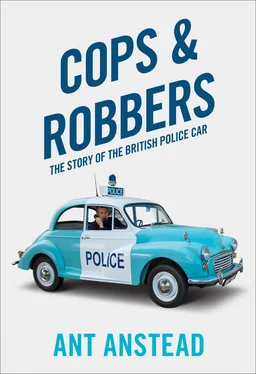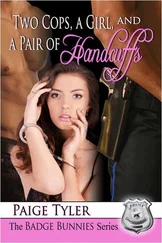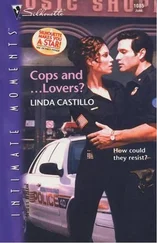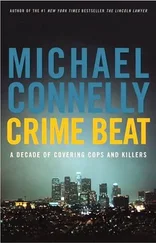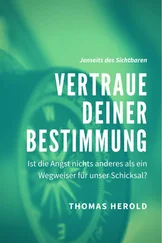The next morning as I sat in the kitchen eating my breakfast, I switched on the local radio station to listen to the news. It was the main headline, ‘Police car explodes into flames in Havant after crashing into a gas main but thankfully with no injuries!’ A wry smile came over my face but it was immediately wiped off when a local resident was interviewed and stated that it was ‘one of them motorway cars’.
It transpired that the area car crew were on a shout, in the wet, and as they negotiated a right-hand bend they lost it, over-corrected it, entered the forecourt of a local house and collided with a cast-iron box about two feet square that contained the mains gas pipe to the house. The Senator landed on top of the box and as the escaping gas met the exhaust manifold … boom, up it went. That same local resident went on to say that the 20-foot-high flame coming through the bonnet resembled one of those Bunsen burners we used at school! Needless to say, we didn’t get the Senator back and the area car crew never asked us for another one!

‘Panda Car; noun (plural, panda cars), a police patrol car; originally white with black stripes on the doors.’
Oxford Concise Dictionary
It’s not every day you discover that one of Britain’s best-loved institutions is wrong! But then it is somewhat of a surprise that the term is in the Oxford Dictionary at all. What is annoying but not a complete surprise is that their definition is wrong, because it states that the cars were white with black stripes on the doors. Over the years, the public’s perception of what constitutes a ‘panda car’ has become blurred, so maybe now is the time to put to bed a few misconceptions, blow away a couple of myths and establish once and for all that not all police cars are in fact pandas.
So, let’s go back to the Oxford definition. Where did the name ‘panda’ originate? And why has the term continued to be used into the twenty-first century when the last real panda cars became extinct way back in the early 1980s?
Mid-1960s Britain was facing a bit of a police recruiting crisis; there simply weren’t enough officers to go around (nothing new there, then!), particularly on the big new housing estates that were being built all over post-war Britain. It must be remembered that most policemen during this period walked the beat or rode a bicycle and police cars were few and far between. Sure, every force had a Traffic Division, whose responsibilities consisted of attending road traffic accidents, escorting abnormal loads and, in one or two counties, policing the new motorways. Traffic didn’t attend such routine calls as domestic disputes, pub fights or kids kicking footballs against people’s windows.
Most stations would have had access to a van to transport prisoners, and there might have been an unmarked car that could be used by a supervisory officer of at least Sergeant in rank, to check up on the foot patrols at various ‘points’ throughout the day. As a member of the public requiring police attendance you could wait quite a long time for an officer to plod his way across his beat to get to you, and it has to be said that the beat bobby could be virtually invisible to the public, especially at night. The modern-day notion that in the ‘good old days’ there were 6-foot 5-inch coppers everywhere you looked, clipping young scrumpers around the ears, is little more than an urban legend, a myth that has been told over and over again and even appeared in Just William and other fiction. If your beat was just one mile square it would take you all day to patrol every street just once, therefore these legends of law enforcement were certainly not seen on every street corner, outside every school or lurking behind the walls of every orchard.
And therein lay the problem. There just weren’t enough coppers to go around. And society in general was moving faster as cars became more accessible to the general public and reliable, too. The solution to this dilemma was brilliant, Unit Beat Policing, or UBP, changed the face of policing in Britain. In 1964 the Chief Constable of the Lancashire County Constabulary, Colonel Eric St Johnson, who was a frequent visitor to the USA, had noticed that in many cities their patrol cars were black with white doors and had the word ‘police’ on them, surmounted by the town’s coat of arms. This made them stand out from the usual plain cars used by the public so that they were easily identifiable as police cars. He brought the idea home and had a couple of Mk3 Ford Zephyr 4s, which until now had been unmarked crime cars, dragged into the police workshops where they were resprayed into the blue and white colour scheme. Colonel St Johnson liked the idea that light blue be the chosen colour because he was a Cambridge University man! He worked with William ‘Palf’ Palfrey, the Chief Superintendent of Accrington, a division within the Lancashire County Constabulary that developed theories on how policing would change post war to cope with the needs of changing work patterns, mobility and mechanisation. Experiments with detailed versions of the basic idea were carried out in both Kirkby and Accrington; the Accrington idea being foot patrols backed up by teams of mobile detectives rather than bobbies moving between ‘beats’.
Lancashire has long been recognised as an innovative force, and the concept of using blue and white cars developed very quickly during the Zephyrs’ trial period in Kirkby – and of the two towns this was considered the very much more successful system.
Because the cars were readily identifiable as police cars, the force could use them to cover a greater area far better and quicker than a bobby on foot patrol. The cars were an instant success and there were calls to expand the idea. At the same time officers were being issued with new hand-held Pye pocket phones, a two-piece personal radio which meant they could now keep in touch with the station. The logic wasn’t that cars became the patrolling medium; the theory of Unit Beat Policing was that the bobby on the beat drove to an area, did a foot patrol, then drove to another area and did another foot patrol or waited to speak to members of the public by his car. Of course, as radio response became ever more immediate, this blurred – but that’s another story. The Government were very much keeping track of these experiments and eventually carried out further trials. The idea was even debated in Parliament under reforming Home Secretary Roy Jenkins at one point; if you are of a mind, you can read this on the Hansard Parliament website. Have a pot of strong coffee to hand.
Lancashire led the way, and in the wake of their success the Government issued a recommendation that forces follow their lead. Ironically, one of the last forces to adopt the system was the Met, who waited until 1970 and then, rather amazingly, introduced Morris Minors as pandas rather than more up-to-date cars, because Morris Minors were a known reliable car that was available and cheap, even if the basic design was from 1948 and the car was getting close to ceasing production – which it did in 1971. As explained elsewhere in the book, the Met had to buy cars that were built in Britain. Some forces, especially those with very different population densities and topography, never adopted the panda car system although they may have used the livery on their cars to a greater or lesser extent. These included the Stirling and Clackmannanshire Police, the Grampian Police and others.
In 1966 Lancashire ordered the first official panda cars. They opted to buy a huge number of Ford Anglia 105Es, 175 in fact, to be used as part of this new ‘Unit Beat Policing’ scheme. On 1 May 1966, local dignitaries and the press were invited to attend Lancashire’s HQ at Hutton for the official launch of the scheme before a mass drive-off of all 175 brand-new blue and white Ford Anglias. The Anglia was chosen because it was cheap to buy, at just £500, and easy to maintain. It didn’t need to be a performance car, as part of the scheme was for the officer to drive to part of his beat, park up in an area where the public could see him, put his helmet on and either walk that part of his beat for a while or wait for the public to approach him by his car. The car didn’t need two-tone horns, just the distinctive blue and white paint to make it stand out.
Читать дальше
